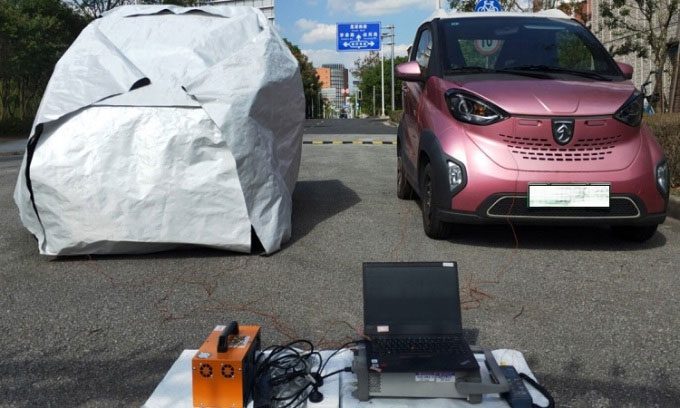The thermal cloak developed by researchers from Shanghai Jiao Tong University can keep vehicle interiors cool during summer and warm during winter nights.
The researchers created a prototype of a fabric that acts as a “thermal cloak”, preventing the underlying surface from becoming excessively hot or cold. Described in the journal Device on July 11, this cloak does not require an external power source and can reduce energy consumption associated with heating and cooling. Globally, heating and cooling account for 38% of energy used in buildings and 12% of total energy consumption. Materials like thermal cloaks can help users stay comfortable during heat waves, leading to a reduction in carbon dioxide emissions associated with electricity used to control temperatures, according to Aaswath Raman, an applied physicist at the University of California, Los Angeles.

The research team testing the thermal cloak with an electric vehicle. (Photo: Huaxu Qiao).
In the new study, Kehang Cui, an engineer at Shanghai Jiao Tong University, and colleagues created a two-layer cloak. The outer layer is made from white silica fibers that reflect visible light, coated with hexagonal boron nitride, a ceramic material that reflects ultraviolet light and aids in heat dissipation. Together, the silica fibers and boron nitride reflect 96% of sunlight that hits the fabric. Simultaneously, the outer layer absorbs heat from the surrounding environment and emits energy in the form of infrared light, contributing to lower temperatures beneath the cloak through a process known as radiative cooling.
While the outer layer keeps the surface beneath the cloak cooler for longer than the uncovered area, the shaded section gradually warms up throughout the day. The inner layer, made from aluminum foil, helps retain warmth at night by trapping some of that heat, similar to an emergency thermal blanket.
The research team tested the durability of the cloak under extreme conditions. They heated the fabric layer to 800 degrees Celsius, hot enough to melt table salt. They also exposed it to extremely cold environments by submerging it in liquid nitrogen, subjecting it to vibrations similar to those experienced during rocket launches, and exposing it to acid splashes and flames from a torch. None of these conditions altered the structure or performance of the material. This durability allows for potential applications of the material in spacecraft or extraterrestrial environments.
To test the fabric layer in real-world conditions, Cui and colleagues created a full-size prototype cloak and tested it with an electric vehicle. On a summer day in Shanghai, the cloak maintained the vehicle’s temperature at 23 degrees Celsius, 8 degrees Celsius lower than the surrounding environment and 28 degrees Celsius lower than the interior temperature of an uncovered vehicle. The cloak also kept the vehicle warmer by 5 degrees Celsius compared to the outside temperature on winter nights. Next, the research team plans to test the product in larger field trials, such as rooftop applications, to assess its impact on daily life.


















































